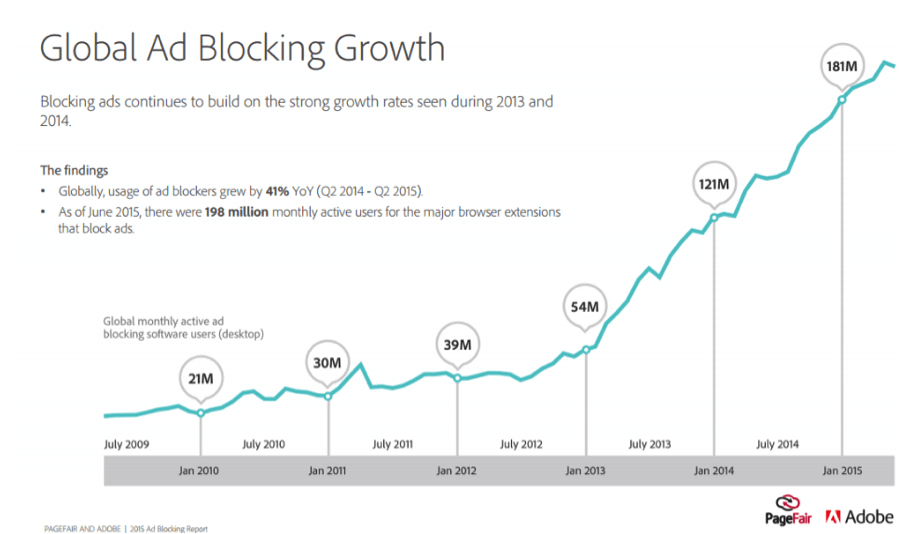Ad blocking is not, by any means, a new phenomenon. Since the arrival of the first online banner ad in 1994, the online advertising space has exploded, with millions of brands utilizing myriad ad formats across countless channels.
With the rise of the smartphone and development of Internet-beaming flying things, humans are spending more time online than ever before. It’s estimated that the average person now sees up to 3000 online ads a day—overwhelming, to say the least.
It should come as no surprise that consumers are already beginning to revolt against such sensory overload. The earliest approaches to ad blocking, such as manipulating local files on your computer, have been around since day one. Quite frankly, it’s something we’ve all been okay with ignoring, until recently. The enormous, user-friendly ad blocking technology market has exploded in recent years and with an increasingly tech-savvy population, and it’s something advertisers can’t afford to ignore any longer.

As it stands, an estimated 198 million consumers use ad blocking software on desktop and Android devices. Furthermore, Apple’s announcement of the Content Blockers feature in its new iOS 9 operating system unleashed ad blocking capabilities to 700 million iPhone users. With ad blocking software downloads increasing by 41% in the last year alone, PageFair and Adobe predict that ad blocking will cost advertisers US$41.4 billion in lost global revenue in 2016.
To better understand what this means for you—and what you can do about it—let’s take a step back and look at the bigger picture.
Why Use Ad Blockers in the First Place?
In addition to the obvious—removing a barrage of often-annoying ads—there are many reasons why more users are using ad blocking tools.
Preventing ads means pages load faster, battery life improves, and device resource waste is reduced (e.g., bandwidth, memory, and CPU). For mobile users on a pay-per-usage data plan, there is a direct financial benefit as ads can often chew through a user’s data allowance, especially in the age of video ads on a 4G connection. And let’s not forget privacy; blocking ads and associated ad content also effectively disables many ad measurement tools, which renders the users’ page visits invisible to the advertiser.

What Is Ad Blocking and How Does It work?
Ad blocking can be loosely defined as the process of identifying and preventing ad content from being displayed to the user. It works because ads are stored on a different server than the “actual” web content and often has characteristic elements or behaviors, which can be matched against a list of known domains or entities and prevented from loading on a user’s screen.
There are many methods that can be used to achieve this, but broadly speaking, these fall into three key categories:
- Browser Extensions (e.g., AdBlock) – These plug into existing browser frameworks and apply filtering to prevent the rendering of specific content that is characteristic of an ad—like a URL that points to an ad server, elements which use technologies such as Adobe Flash/Shockwave, or contains specific elements such as HTML5 that are typically used for audio and video ads. Their effectiveness and applicability can depend on the browser they’re attached to.
- External Applications (e.g., Privoxy) – These are standalone applications that use a customized HTTP proxy (a middle man between the website server and the user’s browser) to cache and filter content before it is rendered in the browser. These apps are more limited than browser plugins, as the full web page content is often not available at the time of filtering due to traffic being encrypted via SSL or something similar. Another reason: the site contains Javascript-generated dynamic content. They are, however, advantageous in that they’re not browser-specific and offer a centralized solution.
- Server Redirection (e.g., DNS cache manipulation) – These methods vary but generally work by manipulating the local hosts file, local DNS cache, or DNS server configuration. These are responsible for mapping human-readable domain names to numerical IP addresses (the actual web address) when loading a web page. URLs pointing to known ad servers are simply redirected to an invalid or incorrect address (e.g., 127.0.0.1 or 0.0.0.0) instead, such that the ad content is unable to be retrieved and loaded.
The end effect of this is that users do not see ad content loaded, but often at the expense of the full website functionality, as many key interactive elements of web pages, like buttons, also depend on the same technologies as those used to deliver ads.
Why Is This a Problem for Advertisers?
For advertisers, it really boils down to two themes:
- Your ads aren’t being seen – This comes hand-in-hand with the viewability discussion where you could be paying for ads that may not actually be seen. Depending on the ad blocking mechanism used, just because ads were not visible to the user does not mean they were not served. Depending on what the publisher defines as an impression, and what your buying methods are (cost per impression, cost per action etc.), you could be paying a lot to reach… well, no one.
- Lack of measurement – In addition to preventing ads from loading, ad blocking can also render ad measurement tools ineffective in an effort to protect user privacy. This means advertisers may be unable to track what users are actually doing on their websites, leaving them in the dark and limiting the potential for retargeting.
Can You Get Users to Turn Off Ad Blockers?
Ad blockers can cause some sites to load with missing content and not function properly, so users may grow frustrated and disable them. Some sites go as far as detecting if users have an ad blocking plugin installed and prompt them to disable it in order to view the page content. This can deter a high number of users, but is an effective way of ensuring ad content will be loaded and measured.

What If They Don’t? What Else Can You Do?
Remember, an estimated 3.25 billion people use the Internet; 198 million is a lot of users, but this only comprises 6% of the global Internet user base. You can still find success by revisiting your approach:
- Identify your target audience: Figure out how much this actually affects you. Who is your target audience? Are they likely to use ad blocking? The coveted Millennials demographic is leading the charge, with 41% of 18-29 year olds reportedly using ad blocking software, but you can soften the impact by testing target audiences outside this key demo.
- Make viewability a priority: Make sure you’re only paying for ads users can see, and choose your platforms and buying methods wisely. For example, bid on a cost-per-click or cost-per-action basis rather that cost-per-impression.
- Shift to social and in-app advertising: Social media platforms fare better as their ad units mimic organic content, and the ability to precisely target ads also ensures relevancy for the user, leading to a better experience. While some ad blocking tools do successfully target social media ads on desktop and the mobile web, they don’t work on in-app ads, so consider shifting your budget to in-app mobile ads.
- Invest in high quality creative: Visually appealing, engaging, entertaining and relevant ads can actually add value to user experience. “I haven’t seen a digital or mobile piece of creative that has tugged the same way as television creative…I do think creative is such a big part of it that we have just ignored and focused so much on the tech,” Condé Nast Entertainment Chief Revenue Officer Lisa Valentino said. “As a result, we may be in a world where it’s more beneficial for consumers to feel like they need to block ads.”
- Rethink your organic content: Focus on producing high quality content (blog posts, etc.) to drive organic traffic. Look at the drop-off points on your conversion funnel and sharpen your landing pages. Focus on improving conversion rates of those in the funnel rather than trying to channel in more and more users.
So, Should You Be Worried?
Ad blockers are on the rise; this will only get worse as people become more tech-savvy and the technology itself becomes more sophisticated. Advertisers are suffering as they are paying for ads that may never been seen and they lose valuable insights as these users become invisible.
But how much does this actually affect brands—and should they be worried? Steve Carbone, Mediacom’s managing director and head of digital and analytics, certainly seems to think so. “We’ve created this problem together,” he said. “It created a bad experience, and users are now voting everybody off the island.”
So choose your audience wisely, focus on achieving viewability, shift your budgets to social media and in-app advertising, invest in high quality creative, and rethink your organic content. It’s a great place to start—and the time is now.
